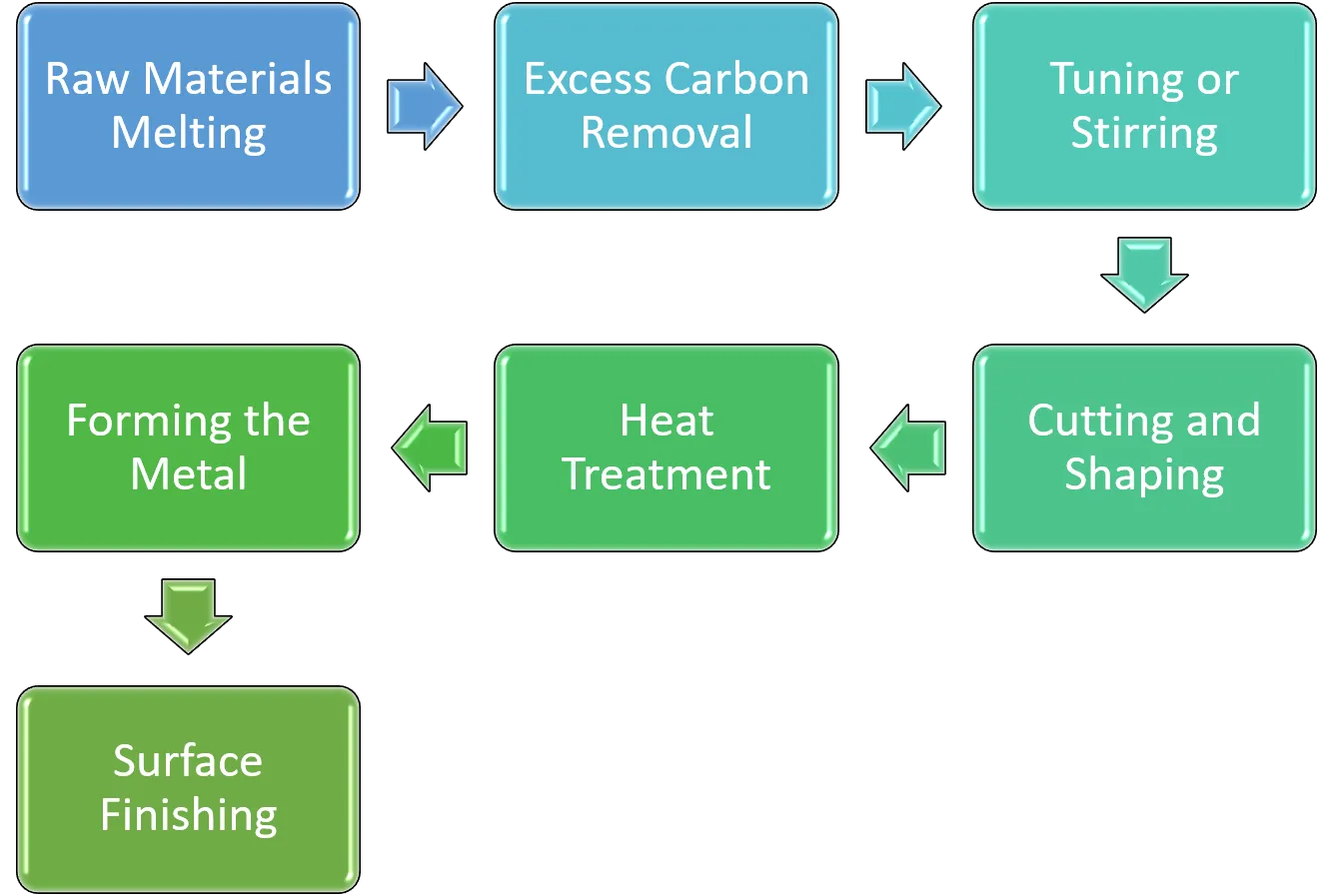Who hasn’t heard of the name steel? I’m sure everyone is aware of it. Because steel equipment does not rust, we frequently seek it out on the market. Because it does not rust, people can use it in a wide range of applications. As a result, stainless steels are well-known commodity in most production areas.
As a result, we will provide the solution to that query in this article. Why doesn’t stainless steel rust? On the other hand, how is the process of making it? What are the requirements? We will address all of these questions in today’s topic. We’ll begin with a broad definition, followed by uses and properties. Then we’ll move on to the material composition and process.
What is stainless steel?
Stainless steel is a category of ferrous alloys with at least 11% chromium, a composition that resists corrosion and offers heat resistance. Carbon (from 0.03 per cent to more than 1.00 per cent), nitrogen, aluminium, silicon, sulfur, titanium, nickel, copper, selenium, niobium, and molybdenum are all components found in stainless steel in various forms.
Stainless steel is also visually pleasing, very sanitary, simple to maintain, highly durable, and provides various features in addition to these environmental advantages. As a consequence, people find stainless steel in a wide range of commonplace items. Energy, transportation, construction, research, medical, food, and logistics are just a few sectors that play a significant role.
Disadvantages of stainless steel
- The expense of manufacturing, finishing, and polishing is high.
- It may be a complicated metal to manage when manufacturing stainless steel without using high-tech equipment and appropriate methods.
- Due to its rapid heat dissipation, damaged parts, and high scrap prices, you may face complicacy.
Stainless steel uses
The manufacturer often utilizes Stainless steel in applications that need steel’s unique characteristics and corrosion resistance. Coils, sheets, plates, bars, wire, and tubing are all machined from this alloy. It’s usually turned into the following application.
- Automobiles and transportation: The manufacturers use stainless steel to make exhaust systems, grills, and trimmings. Manufacturers are increasingly using stainless steel to create structural components as technology advances.
- Medical Facilities: This section favours stainless steel in clean and sterile settings because it is easy to clean and easily corrode. The companies utilize stainless steel to manufacture a variety of medical devices, including surgical and dental tools.
- Building constructions: Stainless steel application has become a vital part of the construction profession due to its strength, resilience, and flexibility. People frequently utilize it on the inside on worktops, backsplashes, railings, and outside high-impact structures as cladding.
- Aircraft construction: The engineers use stainless steel in the aviation sector. Because of its strength and capacity to resist high temperatures, they utilize it in various applications, including the frames of aeroplanes. In addition, they also use it in jet engines to help keep them from rusting.
- Food and catering business: The manufacturers use stainless steel to make kitchen accessories, cookware, and cutlery in the food and catering industry.
Stainless steel properties
Stainless steel has many attractive characteristics that lead to its extensive use in manufacturing parts and components in various industries. Above importantly, due to the chromium concentration, it is very corrosion resistant. Steel with a minimum chromium concentration of 10.5 per cent is 200 times more corrosion resistant than steel without it.
- The chromium content in stainless steel is primarily responsible for its corrosion resistance. On the surface of the steel, a stable coating of chromium oxide forms, preventing chemical interactions with the bulk of the material. This oxide layer is very thin, measuring 2 nm to 3 nm in thickness, and is passive (corrosion-resistant), tenacious (adheres well to the bulk), and self-healing (reforms when cracked or damaged).
- Stainless steels that are ferritic, martensitic, or duplex are magnetic, while austenitic is not.
- Stainless steel is 100 per cent recyclable. Scrap stainless steel recycling is highly cost-effective since it contains many precious components such as chromium and nickel.
Categories of stainless steel
Stainless steels have four main categories according to their crystal structure.
Ferritic
The Ferritic stainless steels are less flexible than other stainless steels, resulting in decreased formability. They are also magnetic, have limited hardness, and have low corrosion resistance. Their lack of nickel, on the other hand, lowers their price.
Austenitic
The most prevalent kind of stainless steel is austenitic stainless steel. Their cubic crystal structure is face-centred. These steels include nickel, manganese, and nitrogen, in addition to the usual alloying components of iron and chromium.
Martensitic
Magnetic stainless steels with high ductility and toughness are known as martensitic stainless steels. You may use cold working to harden them somewhat. In this case, they usually have yield strengths of about 275 MPa after annealing.
Duplex
The strength of duplex stainless steel is approximately double that of austenitic stainless steel. It is more resistant to chloride stress corrosion cracking than austenitic stainless steel in this situation. They have a toughness that is between ferritic and austenitic.
Does stainless steel rust?
A steel alloy with a minimum chromium concentration of 10.5 per cent is known as stainless steel. The chromium interacts with oxygen in the air to create a protective coating, making stainless steel very corrosion and rust-resistant. There are approximately 150 different types of stainless steel on the market right now.
Stainless steel types
While hundreds of different stainless steel alloys are available, the most will fall into one of the three groups below.
- Austenitic stainless steel: This kind of stainless steel has two significant features. Austenitic stainless steel contains a considerable amount of chromium to begin. Corrosion resistance is improved when the producers use this material. Second, these objects are typically non-magnetic, but a cold forming procedure may make them magnetic. The following are the most prevalent stainless steel alloys.
- Ferritic Stainless Steel: This is the second most prevalent stainless steel alloy, and it is also magnetic. Because of the reduced nickel concentration, items made with this alloy may be toughened via cold forming and are less costly than other kinds.
- Stainless Steel Martensitic: This is the least frequent kind of stainless steel alloy. The production utilizes martensitic stainless steel in applications that need impact resistance or high tensile strength. The producer often couple this material to enhance corrosion resistance with a protective polymer covering.
How is stainless steel made?
When producing stainless steel, the producer must first decide the kind of stainless steel they want to create. This instance is significant because the grade of stainless steel they intend to produce will impact the ratio of stainless steel components present in the combination, such as iron, carbon, nickel, etc.
The remainder of the stainless steel production process may begin after you have collected the raw materials. The following sections will go through the industry’s stainless steel production process.

First, the manufacturers heat various stainless steel materials to their melting points in a furnace. They put the molten material in a vacuum oxygen decarburization (VOD) or argon-oxygen decarburization (AOD) to remove excess carbon. Thrid, The molten steel may be swirled to help disperse and remove particular stainless steel components from the mixture, which may assist in fine-tuning the quality of the final product.
Fourth, when the stainless steel cools, it undergoes a series of shaping operations, beginning with hot rolling while the steel is still above its crystallization temperature. Fifth, it may be annealed to alleviate internal tensions and change the mechanical characteristics of stainless steel.
Following the annealing process, the production line subjects stainless steel to various cutting and shaping procedures to provide an appropriate end product for the application. Finally, before exporting stainless steel billets, blooms, or wires to other manufacturers, the stainless steel maker may add various surface treatments to them.
Additives and components of steel composition
Stainless steel components are the material of choice now used to manufacture products and serve the needs of consumers. So, how many different kinds of steel are there? It depends on their additives. So, let’s check them out.
- Carbon: The companies produce steel of carbon and iron alloyed together. Iron gains strength and hardness as a result of this process.
- Manganese: Adding manganese to steel increases hardness, strength, and hardenability while improving hot working characteristics.
- Chromium: They use chromium to enhance the oxidation resistance of steel.
- Nickel: The producers add large quantities of nickel to high chromium stainless steels to create the most significant steels resistant to heat and corrosion.
- Molybdenum: When combined with chromium-nickel austenitic steels, molybdenum improves resistance to pitting and crevice corrosion, especially in sulfur and chloride-containing environments.
- Nitrogen: Nitrogen, like nickel, is an Austenite-forming element that improves stainless steel’s Austenite stability.
- Copper: Copper is a common residual element in stainless steel. The production add this element to various alloys to provide precipitation hardening properties or enhance corrosion resistance in sulphuric acid and saltwater.
- Titanium: The production often uses titanium to stabilize carbide, especially when it requires welding . Titanium combines with carbon to produce titanium carbides, which are very stable and difficult to dissolve in steel, reducing the risk of intergranular corrosion.
- Phosphorus: They combine often phosphorus with sulfur to enhance machinability. While phosphorus improves the strength of Austenitic stainless steels, it also reduces corrosion resistance and increases the material’s propensity to shatter during welding.
- Sulfur: When added in tiny amounts, sulfur enhances machinability, but it, like phosphorous, has a detrimental impact on corrosion resistance and, as a result, weldability.
Other Additives
- Selenium: Selenium was formerly used as a supplement to improve machinability.
- Niobium/Colombium: The manufacturers use Niobium/Colombium to stabilize steel carbon and function similarly to titanium. Niobium also strengthens alloys and steels, allowing them to withstand higher temperatures.
- Silicon: They utilize silicon as a deoxidizing (killing) agent in the steel melting process, and most steels include a tiny quantity of it.
- Cobalt: When exposed to the solid radiation of nuclear reactors, cobalt becomes highly radioactive. Therefore all stainless steel used in nuclear power plants will have cobalt limits, usually 0.2 per cent at most.
- Calcium: The producers add calcium in tiny quantities to improve machinability without compromising other characteristics caused by selenium, phosphorus, and other elements.
Conclusion
Stainless steels include at least 10.5 per cent chromium, less than 1.2 per cent carbon, and other alloying components. There are a variety of locations where people use stainless steel for various purposes.
Stainless steel comes in a variety of forms, depending on the combination of other additions. Manufacturers blend these additives into the stainless steel composition depending on the intended use.
